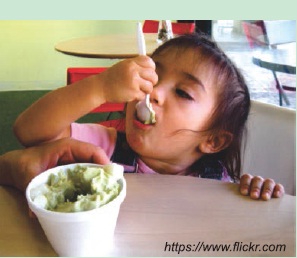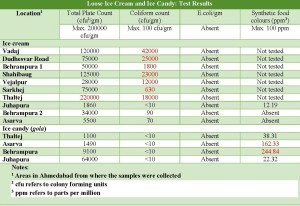Apr.19: COVER STORY
- Posted by CERC India
- Posted in 2019
Loose ice cream: A dangerous dessert
70% ice cream samples had extremely high levels of coliform bacteria; 50% gola samples had food colours above limit
You just can’t stop at one spoonful! You know ice cream is full of sugar and fat but you forget all about calories as it melts in your mouth. A popular dessert, ice cream is sold in packages or loose at retail outlets. Loose ice cream is usually distributed manually in scoops, cones or sundaes.
As children of vulnerable age groups form the bulk of ice cream consumers, it is vital that it is microbiologically safe. To assess safety, CERC tested samples of loose ice cream and ice candy (gola) from different parts of Ahmedabad. The test findings were somewhat alarming, indicating microbiological contamination.Â
What ice cream containsÂ
Ice cream is a pasteurized mixture of milk, fat, non-fat milk solids, sugar, emulsifiers and stabilizers, frozen water (ice crystals), flavouring and colouring agents, and air bubbles. These ingredients are made into a soft, creamy substance using special techniques and frozen. Fruits, nuts, candies and syrups are optionally added.
Ice golas are ice candies prepared with crushed ice flavoured with edible coloured syrups. They are made in makeshift stalls usually under unhygienic conditions. The water used to prepare the ice may be contaminated and can cause serious infections. These stalls are not inspected and, often, the product does not meet the limits for artificial food colours and flavours.
Sources of contamination
Food poisoning is generally caused due to bacterial contamination. Ice cream is a good medium for microbial growth due to high nutrient value, almost neutral pH value and long storage duration.
Primary sources of microbial contamination of ice cream include water and raw milk, whereas secondary sources include flavoring agents, dirty utensils and equipment, and unhygienic handling. Ice cream can get contaminated during production, transit or storage. Improper storage (including not maintaining required temperature) leads to multiplication of pathogens to infective doses.
Pasteurization can destroy most of the pathogens if properly done. However, microbiological hazards can be introduced after pasteurization through contaminated ingredients and improper handling.
Leaving food open, inadequate hand-washing by food handlers (especially after toilet use) and coughing and sneezing near the food without covering the mouth and nose, can lead to contamination. Often, loose ice cream and gola is sold on streets in a dirty environment by food handlers with limited education and poor knowledge of hygiene.Â
Our testsÂ
CERC’s in-house laboratory tested 10 samples of loose ice cream (cups) and 4 gola samples randomly picked up from eight different areas of Ahmedabad city.
The samples were tested according to limits set by the Food Safety and Standards Authority of India (FSSAI). The limits for the four parameters are as follows:
- Total Plate Count – maximum 200000 cfu/gm (where cfu stands for colony forming units)
- Coliform count – maximum 100 cfu/gm
- E Coli/gm – should be Absent
- Synthetic food colours – maximum 100 ppm (parts per million)
Significance of parametersÂ
Total Plate Count: This test determines the total number of aerobic bacteria and is an indicator of the bacterial populations of a sample.Â
Coliform bacteria: This group of bacteria is important in quality control as it is indicative of possible faecal contamination. Also, the presence of coliform organisms is taken as an indication that other pathogenic organisms may also be present in the sample. Exposure to pathogens like coliforms can cause bloody diarrhoea, vomiting, gastroenteritis, urinary tract infections and typhoid.
Escherichia coli (E. coli): Most E. coli are harmless but some are pathogenic and can cause severe diarrhoea, abdominal cramps, nausea and vomiting. E. coli can cause an infection even if you ingest small amounts.
Artificial food colouring: Food dyes make food appealing but have been linked to cancer, DNA damage and attention-deficit disorder and hyperactivity in children.
KEY FINDINGSÂ
- Of the 10 loose ice cream samples, 7 had very high Coliform count, much above the limit. (See table for details)
- Only one sample had Total Plate Count above the limit.
- E. coli was absent in all the samples.
- The three samples of loose ice cream tested for synthetic food colours had food colours within the limit.
- Of the four gola samples, two had synthetic food colours above the maximum limit.
- All four gola samples had microbiological parameters within the limits.
Areas of action
- Manufacturers should obtain ingredients from licensed sources and store both ingredients and final product at proper temperatures.
- They should keep all equipment clean and observe hygienic practices during preparation.
- Regulatory bodies should constantly monitor quality to ensure food processing standards are maintained at production, processing, packaging and storage stages.
- Food handlers need to be educated on the importance of good sanitary practices.Â
Advice to consumersÂ
- Consumers should buy ice cream from reputed shops after checking the expiry date.
- They should store ice cream in the freezer after purchase. Never allow ice cream to thaw and re-freeze it.
Our conclusionÂ
The presence of coliforms in 70% of loose ice cream samples tested is a matter of concern. It could indicate faulty pasteurization. Other reasons for contamination may come from water, lack of personal hygiene of the food handlers or dirty utensils used for storing ice cream. It is essential that food business operators manufacture/sell healthy and safe food to consumers.






